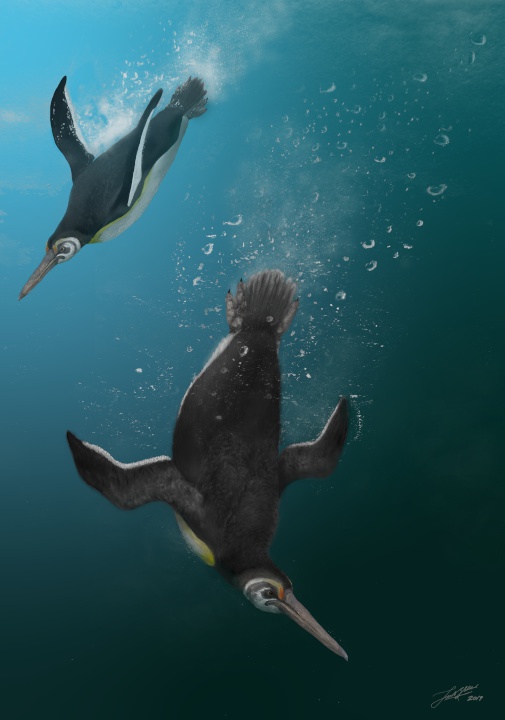When penguins ruled after dinosaurs died
Chatham Island provides missing link in
evolution

What waddled on land but swam supremely in subtropical seas more than 60 million years ago, after the dinosaurs were wiped out on sea and land?
Fossil records show giant human-sized penguins flew through Southern Hemisphere waters – along side smaller forms, similar in size to some species that live in Antarctica today.
Now the newly described Kupoupou stilwelli has been found on the geographically remote Chatham Islands in the southern Pacific near New Zealand’s South Island. It appears to be the oldest penguin known with proportions close to its modern relatives.
It lived between 62.5 million and 60 million years ago at a time when there was no ice cap at the South Pole and the seas around New Zealand were tropical or subtropical.
Flinders University PhD palaeontology candidate and University of Canterbury graduate Jacob Blokland made the discovery after studying fossil skeletons collected from Chatham Island between 2006 and 2011.
He helped build a picture of an ancient penguin that bridges a gap between extinct giant penguins and their modern relatives.
“Next to its colossal human-sized cousins, including the recently described monster penguin Crossvallia waiparensis, Kupoupou was comparatively small – no bigger than modern King Penguins which stand just under 1.1 metres tall,” says Mr Blokland, who worked with Professor Paul Scofield and Associate Professor Catherine Reid, as well as Flinders palaeontologist Associate Professor Trevor Worthy on the discovery.
“Kupoupou also had proportionally shorter legs than some other early fossil penguins. In this respect, it was more like the penguins of today, meaning it would have waddled on land.
“This penguin is the first that has modern proportions both in terms of its size and in its hind limb and foot bones (the tarsometatarsus) or foot shape.”
As published in the US journal Palaeontologica Electronica, the animal’s scientific name acknowledges the Indigenous Moriori people of the Chatham Island (Rēkohu), with Kupoupou meaning ‘diving bird’ in Te Re Moriori.
The discovery may even link the origins of penguins themselves to the eastern region of New Zealand – from the Chatham Island archipelago to the eastern coast of the South Island, where other most ancient penguin fossils have been found, 800km away.
University of Canterbury adjunct Professor Scofield, Senior Curator of Natural History at the Canterbury Museum in Christchurch, says the paper provides further support for the theory that penguins rapidly evolved shortly after the period when dinosaurs still walked the land and giant marine reptiles swam in the sea.
“We think it’s likely that the ancestors of penguins diverged from the lineage leading to their closest living relatives – such as albatross and petrels – during the Late Cretaceous period, and then many different species sprang up after the dinosaurs were wiped out,” Professor Scofield says
“It’s not impossible that penguins lost the ability to fly and gained the ability to swim after the extinction event of 66 million years ago, implying the birds underwent huge changes in a very short time. If we ever find a penguin fossil from the Cretaceous period, we’ll know for sure.”
‘Chatham Island Paleocene fossils provide insight into the palaeobiology, evolution, and diversity of early penguins (Aves, Sphenisciformes) by JC Blokland, CM Reid, TH Worthy, AJD Tennyson, JA Clarke and RP Scofield will be published in Palaeontologia Electronica 22.3.78 1-92 https://doi.org/10.26879/1009 – the oldest electronic professional, peer-reviewed journal of paleontology sponsored by the Palaeontological Association, the Paleontological Society, and the Society of Vertebrate Paleontology
palaeo-electronica.org/content/2019/2773-chatham-island-penguins
BACKGROUND: The new species is based on the fossilised bones of five partial skeletons. Another two specimens showed a second larger penguin species was also present on the main Chatham Island but there was not enough material to formally name it. All of the described skeletons were collected between 2006 and 2011 by a group led by Monash University palaeontologist Jeffrey Stilwell. Dr Alan Tennyson from Te Papa Tongarewa the Museum of New Zealand and Professor Julia Clark from University of Texas at Austin were in the group and are also-coauthors of the paper. The species is named after Associate Professor Stilwell with all specimens now cared for by Te Papa.
ends


 Tourism Industry Aotearoa: TRENZ 2026 Set To Rediscover Auckland As It Farewells Rotorua - The Birthplace Of Tourism
Tourism Industry Aotearoa: TRENZ 2026 Set To Rediscover Auckland As It Farewells Rotorua - The Birthplace Of Tourism NIWA: Students Representing New Zealand At The ‘Olympics Of Science Fairs’ Forging Pathway For International Recognition
NIWA: Students Representing New Zealand At The ‘Olympics Of Science Fairs’ Forging Pathway For International Recognition Coalition to End Big Dairy: Activists Protest NZ National Dairy Industry Awards Again
Coalition to End Big Dairy: Activists Protest NZ National Dairy Industry Awards Again Infoblox: Dancing With Scammers - The Telegram Tango Investigation
Infoblox: Dancing With Scammers - The Telegram Tango Investigation Consumer NZ: This Mother’s Day, Give The Gift Of Scam Protection And Digital Confidence
Consumer NZ: This Mother’s Day, Give The Gift Of Scam Protection And Digital Confidence NZ Airports Association: Airlines And Airports Back Visa Simplification
NZ Airports Association: Airlines And Airports Back Visa Simplification